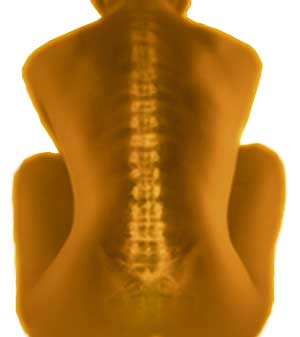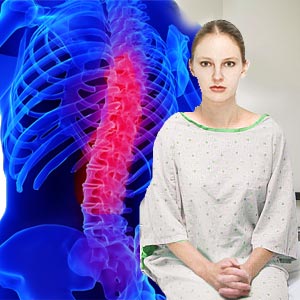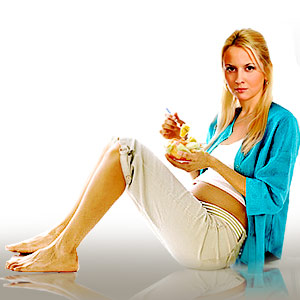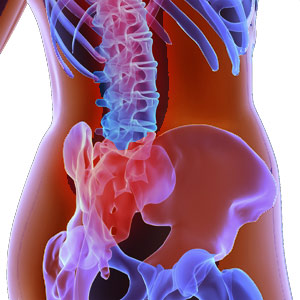Cause of Osteoporosis

Osteoporosis termed as a 'silent thief' is a disorder marked by the decreased bone mass. As aging occurs, this disease silently steals away the essential bone mass required to keep the bones healthy and strong. Find out how osteoporosis is caused and how women are more likely to fall prey to this condition. A few simple lifestyle tips can help prevent osteoporosis.
Cause of osteoporosis
Osteoporosis occurs when bones lose an excessive amount of their protein and mineral content, particularly calcium. Over time, bone mass and bone strength decreases and results in fragile bones that are likely to break at any time. Even a sneeze or a sudden movement may be enough to break a bone in severe osteoporosis. The osteoporosis-affected bones are characterized by large spongy holes. Normal bone marrow has small holes within it, but a bone with osteoporosis will have much larger holes.
With advancing age, the remodeling process (the process of laying down new bone and removing old bone) takes away more bone than is replaced. Starting from around 30 years to the onset of menopause, women lose a certain amount of bone steadily every year:
- Trabecular bone (the spongy bone inside the hard, cortical bone) is lost at a rate of about 1% per year
- Cortical bone (the hard bone) is lost at a rate of about 0.5% per year
Estrogen plays an important part in maintaining bone strength since it maintains low bone remodeling rates. There are two lines of cells for bone remodeling, the bone-eating cells (osteoclasts) and the bone-forming cells (osteoblasts). Without estrogen, the osteoclasts are favored and more bone is lost than laid down, resulting in thinning of the bone. Hence women past menopause are more prone to osteoporosis as their estrogen level decreases. Other causes for osteoporosis are:
- Age - Osteoporosis is more likely to develop in aged people as their bones lose tissue
- Gender - Women are more likely to have osteoporosis because they have less number of bones than men.
- Lifestyle - People who smoke or drink too much and those who do not get enough exercise are at the increased risk of osteoporosis. Diets that do not supply adequate amounts of calcium and protein are also responsible for onset of osteoporosis.
Osteoporosis can be classified into two categories - primary and secondary. Primary osteoporosis is associated with bone loss, which is prevalent in older persons and post menopause women. Secondary osteoporosis results from chronic conditions that contribute significantly to accelerated bone loss. These chronic conditions may include
- Metabolic bone disease, such as hyperparathyroidism
- Neoplasia, as with multiple myeloma or metastatic carcinoma
- Malnutrition
- Drug therapy, as with corticosteroids
- Prolonged immobilization
- Weightlessness with space travel
- Renal failure
- Other connective tissue diseases
Osteoporosis Prevention
The following tips may help you prevent osteoporosis:
- Eat a well balanced diet. Take essential calcium, which is required for building and maintaining healthy bone. Vitamin D is rich in nutrients and helps you absorb calcium.
- Avoid smoking and excess alcohol intake.
- Exercise regularly for osteoporosis prevention. Exercises where muscles pull on bone cause the bones to retain and possibly gain density.
- Good sources of calcium include dairy products, leafy green vegetables, nuts, and seafood. Most women get only about half of the calcium they need everyday so taking a calcium supplement is often advisable to prevent osteoporosis.
Symptoms of Osteoporosis
Often doctors and nurses term osteoporosis as the silent bone killer, since it is asymptomatic in most cases, except the fractures. Typical symptoms are joint aches and muscle aches. Advanced cases of osteoporosis may be characterized by:
- Thin bones
- Brittle bones
- Easy fractures
- Back aches
- Loss of height
- Spine deformation
In advanced stages, there may be chronic or dull pain in the vertebra or lower back or neck. However, most people may not know that they have osteoporosis until their bones break down resulting in fracture or vertebra to collapse.
Diagnosis of osteoporosis
Diagnosis of osteoporosis may include a series of tests such as bone densitometry (a bone density scan) performed by your physician. There are three types of bone density scans: dual-energy x-ray absorptiometry (DEXA), single photon absorptiometry (SPA), and quantitative computed tomography (QCT). The most common bone density scan is the DEXA. DEXA measures bone density based on how bone absorbs two sets of photons (atomic particles with no electrical charge) generated by an x-ray tube. Physicians prescribe that postmenopausal women under age 65 should have a bone density test if they have one or more of the risk factors for osteoporosis, such as low calcium intake, smoking, or minimal physical activity.
Osteoporosis treatment
Osteoporosis treatment aims to prevent fractures and increase the density of bones.
Hormone replacement therapy (HRT) - This therapy is undertaken to restore estrogen to a pre-menopausal level. It aims to relieve menopausal symptoms such as hot flushes, night sweats and vaginal. HRT also helps to reduce the risk of heart disease.
Some women may experience breast tenderness and nausea as side effects of the treatment. HRT can also increase the risk of developing breast cancer and uterine cancer, but the risk remains low. There are over 30 forms of HRT available as pills, patches, under-the-skin implants or gels. Apart from HRT, the other treatments for osteoporosis include calcium rich nutrients; weight bearing exercises and medications rich in Vitamin D. Vitamin D and calcium supplements are regularly used in treating osteoporosis.
SERM or Selective Estrogen Receptor Modulators are hormone replacements that mimic the effect of estrogen on the bones, thereby reducing the risk of osteoporosis. They slow down the rate at which bone is dissolved. Non-hormonal medicines such as bisphosphonates block the breakdown of bones.
Osteoporosis exercise
Regular exercise keeps your bone healthy and strong. It can go a long way in keeping osteoporosis at bay. Osteoporosis exercises include walking, jogging, hiking and dancing. Apart from bone density, these exercises also increase the strength, co-ordination and balance, thereby reducing the risk of falls. There are special exercise for spine, hips and wrists. Consult your physician before embarking on an exercise program.
Running, skipping, aerobics, tennis and weight training are ideal osteoporosis exercises that can be undertaken thrice a week for at least 30 minutes. Weight training is known to have a positive effect in increasing bone mass and thereby preventing osteoporosis. The benefits of walking regularly cannot be discounted in preventing osteoporosis. A regular schedule of brisk walking for about 20 minutes 4 times a week is ideal for osteoporosis exercise. Walk briskly enough to become slightly short of breath.
A little puffing shows that you're working your body hard enough to improve your fitness. If you have certain lung, heart, or other medical conditions, you should consult your doctor about a safe level of activity
Those leading a sedentary lifestyle are at greater risk of low bone mass and osteoporosis. Embarking on a regular exercise regimen, after consulting a physician can be your greatest insurance against bone loss and osteoporosis.
Top of the Page: Cause of Osteoporosis
Tags:#osteoporosis #osteoporosis treatment #osteoporosis exercise #osteoporosis symptom #cause of osteoporosis #osteoporosis prevention #prevent osteoporosis #osteoporosis diagnosis
 Slipped Disc
Slipped Disc Knee Replacement for Women
Rheumatoid Arthritis
Osteoarthritis
Drop Wrist Deformity
Ankylosing Spondylitis
Spinal Decompression
Scoliosis Treatment
Cause of Osteoporosis
Osteopenia
Bone Density Test
Disc Herniation
Tennis Elbow Symptoms
Restless Leg Syndrome Symptoms
Other health topics in TargetWoman Women Health section:
General Women Health

Women Health Tips - Women Health - key to understanding your health ...
Cardiac Care
Women's Heart Attack Symptoms - Identify heart problems...
Skin Diseases
Stress Hives - Red itchy spots ...
Women Disorders
Endocrine Disorder - Play a key role in overall wellbeing ...
Women's Reproductive Health
Testosterone Cream for Women - Hormone replacement option ...
Pregnancy
Pregnancy - Regulate your lifestyle to accommodate the needs of pregnancy ...
Head and Face
Sinus Infection - Nearly 1 of every 7 Americans suffer from ....
Women and Bone Care

Slipped Disc - Prevent injury, reduce pain ...
Menstrual Disorders
Enlarged Uterus - Uterus larger than normal size ...
Female Urinary Problems
Bladder Problems in Women - Treatable and curable ...
Gastrointestinal Disorders
Causes of Stomach Ulcers - Burning feeling in the gut ...
Respiratory Disorders
Lung function Test - How well do you breathe ...
Sleep Management

Insomnia and Weight Gain - Sleep it off ...
Psychological Disorders in Women
Mood swings and women - Not going crazy ...
Supplements for Women
Women's Vitamins - Wellness needs...
Natural Remedies

Natural Diuretic - Flush out toxins ...
Alternative Therapy
Acupuncture Point - Feel the pins and needles ...
Women Health Directory
Top of the Page: Cause of Osteoporosis
Popularity Index: 101,071

